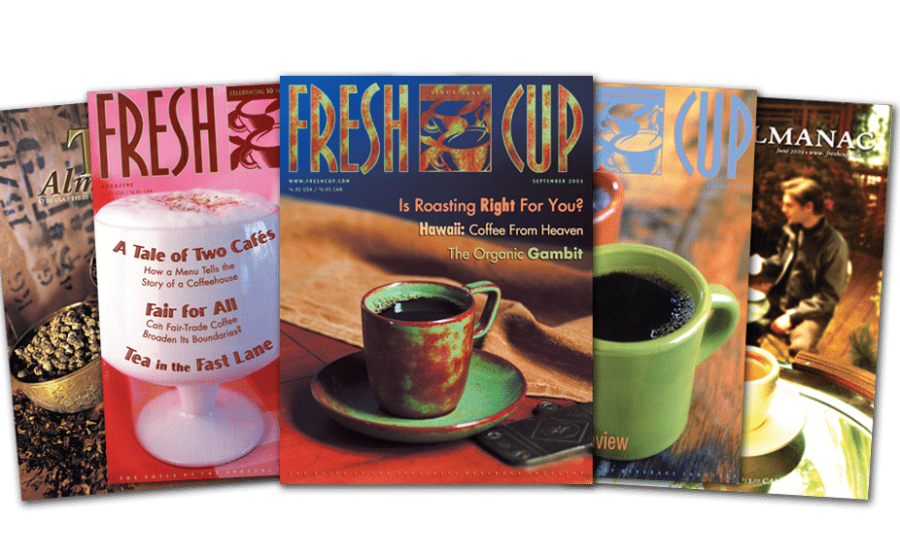[F]rom trends that were accurately predicted, to a call for roasters to visit coffee growing regions, articles in past issues show us how the industry has—and hasn’t—changed.
We spent some time digging through our archives in preparation for our anniversary issue. We’d be remiss not to share with you a few of the gems we unearthed.
(Photos [from top to bottom]: Aubrie Shramko, Cheyanne Paredes, Jay Keywood, Rachel Nortrhop, Bryon Lippincott.)
December 1999, Tea Almanac
Feature, “Bubble Tea”
by Rivers Janssen
“If you’ve ever sipped a bubble tea drink with tapioca balls, you know it is odd. But people are lining up around the country, especially in Asian-dominated neighborhoods, to try bubble tea and tapioca balls for the first time. It’s a legitimate trend. It’s not tea. It’s tea as ‘beverage.’”
September 2002
Feature, “A Tale of Two Cafés”
by Sherri Johns
How menus tell your café’s story—an appeal for a broader menu, offering smoothies, frappes, and more.
What’s changed: Menus now are pared down, simple, and curated. Consumers tend to prefer fewer choices and a minimalist aesthetic over a huge menu with abundant choices.
Feature, “Can Fair-Trade Coffee Broaden Its Boundaries?”
“By its existing definition, fair-trade certification does not cover the majority of the people who tend seedlings, prune trees, bend to dig irrigation ditches, balance on hillsides to harvest coffee, supervise beneficios, or hand-sort beans. These people are just as affected by the price crisis as workers on fair-trade certified farms, and they are facing the same painstaking challenges of eking out a living to feed themselves and their families. Why shouldn’t they be included in the fair-trade model?”
September 2003
Feature, “Ecotourism: How Roasters and Retailers Can Complete the Seed-to-Cup Cycle”
by Karen Foley
Making the case for roasters and retailers to visit countries of origin.

August 2002
Feature, “Hooked on Gadgets: New Toys for the Coffee & Tea Gearhead”
by Fresh Cup Magazine‘s editorial staff
The Disposable Beverage Carafe: “This innovative beverage carafe offers specialty coffee shops a new way to safely transport hot liquid. The body and spout are made from post-consumer materials and can be recycled.”
Feature, “Master Your Domain: 10 Steps to Successful Coffeehouse Management”
by Don Holly
1) Be an expert
2) Defend high quality standards
3) Be passionate about your concept
4) Define your culture
5) Attract good people
6) Train, train, train
7) Give your team the tools it needs
8) Observe and reward
9) Attend to the individuals on your team
10) Give yourself time to think
What’s Changed: This list stands up—though an updated list would be wise to encourage digital media engagement.
June 2005
“Trends in Coffee: Stabilizing the Chain”
“Complex dynamics within the market create instabilities that aren’t easy to predict or prevent. The Oxfam report identifies what it sees as the six most pressing needs of coffee farmers: price stability, access to finance, market access, technical assistance in quality improvement and diversification, organizational strengthening, and participation in international debate. In light of these challenges, more specialty coffee companies are making commitments to sustainable sourcing.”
“Trends in Coffee: Competition from C-Stores?”
“Out with instant cappuccino and bland, burned brewed coffee. In with high-end espresso equipment and the latest brewers. The C-store image makeover is a gamble worth taking.”
What’s changed: Portland, Oregon’s Mini Mini is proof this article had it right; convenience stores are changing. Mini Mini is a convenience store serving Coava coffee, and stocking high-end craft beers, wines, and snacks.
“Cold Brew: Revival of an Ancient Innovation”
“It is estimated that more than 1,000 cafés are using cold-brewed coffee concentrate.”
What’s changed: Cold-brew coffee has become its own category: as an in-café beverage, and on retail shelves as a ready-to-drink product.
“Cyberian Coffee: A 2005 Overview of Online Coffee Resources”
Sites mentioned: Specialty Coffee Association of America, International Coffee Association, National Coffee Association, TransFair USA, forums, blogs (The Coffee Odyssey; EspressoLab; Bread, Coffee, Chocolate, Yoga; Coffee and Caffeine Blog; Vancouver Coffee).
What’s changed: To give an overview of the online resources available to coffee enthusiasts today would take years to compile and too many pages to count. TransFair USA has become Fair Trade USA, and most of those blogs have either disappeared, or haven’t been updated since 2009.



















